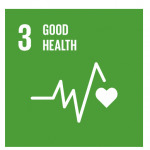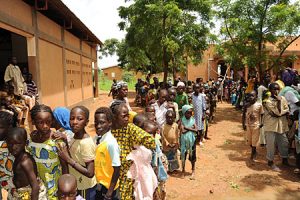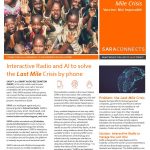 Right now on our planet twenty million children in remote and under-developed regions are under-vaccinated and at risk of being infected by preventable diseases because of the last mile vaccine crisis. According to UNICEF, vaccinations avert up to three million deaths every year from diphtheria, tetanus, pertussis (whooping cough), malaria, polio, cholera and measles – life-threatening diseases that disproportionately affect children.
Right now on our planet twenty million children in remote and under-developed regions are under-vaccinated and at risk of being infected by preventable diseases because of the last mile vaccine crisis. According to UNICEF, vaccinations avert up to three million deaths every year from diphtheria, tetanus, pertussis (whooping cough), malaria, polio, cholera and measles – life-threatening diseases that disproportionately affect children.
But despite the best efforts of pharmaceutical companies, governments and NGOs to deliver critical vaccinations into the neediest at-risk countries on our planet, most of these inoculations never make it to their intended destinations, or spoil due to inadequacies, errors and delays in distribution. The failure at the last mile to timely distribute and dispense vaccines to these remote regions translates into many thousands of needless preventable deaths each year from avoidable diseases.
Some of the world’s most vulnerable populations can be found in Africa and south Asia in the Democratic Republic of Congo, Ethiopia, India, Indonesia, Iraq, Nigeria, Pakistan, Philippines, Uganda, and South Africa. In these nations the last mile vaccine crisis is acute and communications and transportation services limited. But poor education is also a critical factor; for example many vaccinations require periodic booster shots but parents may not realize the need to bring their children for that second or third injection or maintain records of past inoculations.
These people may be unaware of the diseases and risks to which they are exposed and they may be uninformed as to vaccination programs available to them. Conversely, aid workers may not have accurate awareness of local needs, resulting in shortages of necessary inoculations at dispensaries.

Long queues for vaccination
Part of the solution to this last mile vaccine crisis is therefore improved information access and exchange with remote populations most in need. These remote regions are not well served by radio or TV broadcasts. Worldwide 3.9 billion humans in remote regions and emerging markets are disconnected from the Internet and personalized wireless information access. But a high percentage possess basic mobile phones and live within adequate cell tower coverage.
SARA is working to launch Interactive Radio to connect and educate the disconnected using the two-way radio devices they already have in hand – voice-centric analog telephone handsets. And with basic telephony interface as end-user platform, enhanced information flow will help ameliorate the last mile vaccine crisis impact and help get people to the meds they require while authorities collect valuable data that can be used to better anticipate demand and logistics required of a particular region or populace. Human voice and touch-tone commands are all that’s required to use the service from any device.
SARA interactive radio is a smart cloud; the wireless web in the form of a radically new user interface native to the phone, a cloud-based content distribution system fronted by a first-of-its-kind tele-centric web browser, delivering advanced smartphone functionality to the most basic devices with a friendly interface that is universal, uniform and immediately familiar.
Health messaging is embedded into the audio stream as advertising and public service announcements. Listeners have the option of interacting with content and with these spots – the data collected from interactions and behavior can be mined by agencies to manage and enhance dispensation of vaccines and emergency health – optimize locations, inventory movements, transportation of product as well as skilled personnel and needy individuals to and from mobile hospital sites.
Any caller can navigate, chose playlists, customize the interface and content; change venues quickly, repeat segments of interest. With every interaction the service learns more about individual (and community) interests, tastes and preferences – improving responsiveness, better selecting content and better targeting ads. Bookmarks are set automatically, so returning callers can be warmly greeted with suitable content even if they have never registered.
The more people listen, the more they interact and the more the platform learns. This enables massive public health assessments and evaluation via SARA to discover otherwise undetected illnesses and breakouts much earlier and respond.
Deployed in partnership with local carriers feeding live connection data, SARA can enhance content offerings, health messages and learning capacity with location based services. Cellular tower triangulation data identifies the current location of any caller. Though not as precise as GPS, SARA’s location awareness can allow health authorities to measure for hot spots of interest and response to specific messages, and allow for highly targeted alerts to reach only affected persons in specific regions.
SARA’s friendly voice and desirable content fronts a machine learning system that monitors all interactions to serve ever more personalized, relevant content. SARA learns about individual listeners, like minded listeners, communities and populations. Health messaging can include a feedback response so authorities can measure grass roots reaction to health instruction and vaccination announcements and anticipate attendance at local events.
Imagine your handset serving as your health ID. With just a phone number SARA can provide personalized services and track responses to health queries. At hospital, a citizen’s phone number can link to their SARA health and vaccination record. Membership is not required to enable this feature.
Any health message allows listener-access to health professionals for personal guidance. Any caller can instantly reach a live nurse.
Urgency is required to address the last mile vaccine crisis. SARA technology permits rapid deployment of a service compatible with devices saturated into the population, offering radio quality interactive audio via conventional telephony. Her learning, location awareness, data warehousing and data mining systems facilitate complete control and personalization for each caller regardless their status, and logs each unique individual’s lifetime of interactions with the service. At the same time she allows health providers critical community insights and information to be more effective and efficient. This is how interactive wireless information access can help solve the last mile vaccine crisis.
To learn more about SARA and to help us solve this crisis with better access to information, click to contact us and let us know who you are! We are seeking investors and technology partners who share a passion to change the world.







